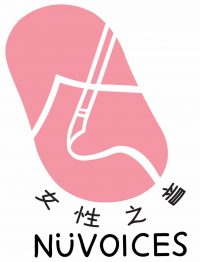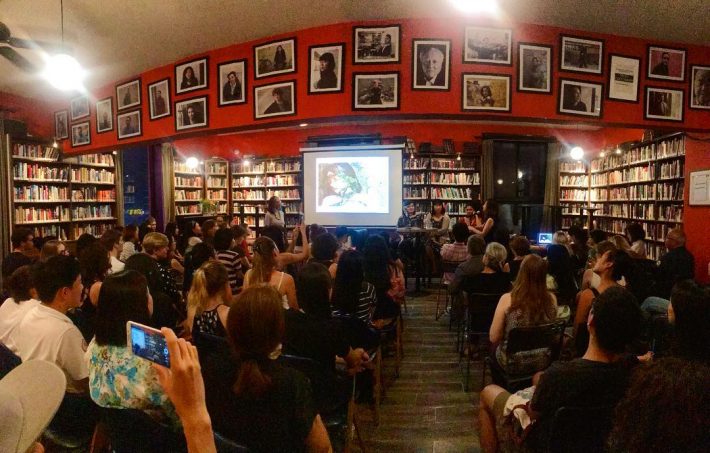BY DAVE YIN
There’s a certain fascination that Li Xinmo’s art seems to have with death.
In one photo, she looks to be a murdered lifeless body floating down a polluted river, her face and hair covered in algae. In another, the barrel of a gun is pointed directly at a vagina. And in a taped public performance, she lies silently in a white dress while soil and a plant are placed on top of her, seemingly growing out of her abdomen.
Except for maybe the second example, not much of Li’s art screams feminist. Yet they represent some of the societal and ecological violence that she sees in her day-to-day life in China, violence that costs a woman’s body.
Li, who lives in Beijing, doesn’t often describe herself as a feminist artist — to open one’s mouth here is to shut doors, she says — and yet she joined three other women to form a panel at a Feminism in Art & Journalism discussion organized by NüVoices in early July.
Among them was also Annabel Gueredrat of Martinique, whose own performances involving dance, music and vocalizations in the nude are, perhaps, the opposite of Li’s in tone in that they focus on resilience.
According to Gueredrat, both black feminism and abuse she experienced as a girl inform her art through which she heals.
“This process is how I own these experiences in my life,” she told the roughly 60-person audience. “I could just say I’m an artist, but if I define myself as a feminist artist, it’s because I want to introduce my intimacy in a political way.”
Likewise, Joanna Chiu decided partway through her stint in China that she wasn’t just a reporter.
The former AFP China correspondent and NüVoices founder had been told by professors back in school that, to be taken seriously, she needed to “put a lid” on her politics. But the often personal risks of reporting in China challenged the notion that she had to be detached from the story.
That’s when she began gathering her experiences, one of which was facing sexual harassment in journalism circles, and asking whether there was a bigger picture. To her surprise, it was a trend. It culminated in what became one of her most widely discussed pieces titled “Sexpat Journalists Are Ruining Asia Coverage.”
“I really think that as a feminist and a journalist, you can still do good work that makes an impact that is also credible,” Chiu says, explaining that in the #MeToo era, identifying as a feminist helps a reporter attune to and appear more approachable for non-traditional stories. “Being a feminist … has really enhanced my work,” she says.
Nevertheless, for artists living in places where visibility comes at a cost, finding support can be a challenge, according to Kate Just. The Australia-based academic who works with sculpture, installation and textiles dedicates part of her energy to simply connecting feminists through group exhibitions, social media and more.
“When you live in repressive societies, what happens is feminists don’t know each other,” she says, adding that this is often the case even for feminists familiar with one another’s work. In her experience, when feminists are brought together they often form a community. Many who have been introduced to other feminists have collaborated or have since been invited to show their work elsewhere.
“It doesn’t take that much effort sometimes to create small communities that then have reverberations,” she says.
To Chiu, as more people around the world become more politically aware, women’s stories will no longer be relegated to the back pages.
“What makes feminist art is that people will take their personal intimate experiences and really have the confidence to bet that it (is) universal,” she says.
About the author
Dave Yin is a Beijing-based Canadian journalist and Curation Editor at Caixin Global. He is a contributor to NüVoices focusing on identity and LGBT issues. Visit his website daveyin.com and follow him on Twitter @yindavid.

